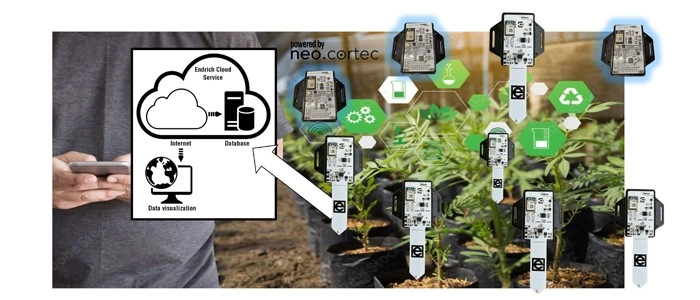
Measuring soil moisture with the endrich IoT ecosystem
The field of application
Soil moisture measurement is one of the key elements of environmental monitoring and IoT solutions for agriculture and horticulture. It involves measuring the amount of water in the top layer of soil, which has a direct impact on plant growth, irrigation strategies and water conservation efforts. Various methods are used to determine soil moisture, from traditional methods such as gravimetric measurements to modern technologies such as capacitance measurement or TDR (Time Domain Reflectometry). The accurate measurement of soil moisture helps to optimise irrigation schedules, avoid over- or under-irrigation, promote sustainable agriculture and ultimately increase agricultural productivity. At the same time, water wastage is minimised. Replacing traditional sensors and control electronics with modern wireless communication units and integrating the IoT is an interesting task that makes sense if you want to get a picture of soil moisture conditions in large fields or plantations using calculation methods based on data from many sensors. In many areas of the world, it is not possible or uneconomical to use smart sensors with a direct sensor-cloud connection (GSM, SAT, etc.). In such cases, the soil moisture sensors can be organised in a wireless ad-hoc network. This utilises renewable energy sources and uses low-power modems to cover a large area. This network has only a single and cost-effective connection to the Internet. The gateway used can operate at the edge of the area using an internet connection and is integrated into the smart sensor network.

The E-IOT platform combined with a low-power local ad hoc network.
In this case, a low-power ad hoc solution for local sensor networks such as the NeoCortec Neo.Mesh protocol is required. A large number of smart sensors can be connected to a local wireless sub-GigaHertz network with low power consumption. A single data concentrator/gateway with internet connection delivers the data to the cloud DB via the mobile network, for example with LTE-M or NB-IoT, even with satellite or cable connection. This modular sensor network infrastructure provides multi-point-to-point communication to the cloud via the LPLAN-LPWAN/WAN gateway.

Wireless E-IoT soil moisture sensor
As an experiment, endrich has developed a sensor that works on the capacitive principle and transmits a signal via the neo.mesh network that is proportional to the moisture of the top soil layer. The "mesh" is suitable for covering large areas due to the use of thousands of nodes. No data is lost, as each sensor also acts as a repeater at a maximum distance of 100 metres and the data simultaneously finds its way to the target gateway. During the day, the integrated solar panel supplies energy for the electronics of each node, while at night the rechargeable battery ensures continuous operation.
Principle of measurement
Capacitive soil moisture measurement is based on the detection of changes in the dielectric constant of the soil under the influence of moisture. As soil moisture increases, the dielectric constant also increases, resulting in a higher capacitance. Moist soil acts like an electrolyte and increases the capacitance of the trace that forms in the part of the sensor embedded in the soil. If you connect the output of a high-frequency square wave signal generator to this capacitance via a resistor, you get an R-C element that acts as a low-pass filter. The amplified voltage signal of a simple diode peak detector, suitable for moisture detection and connected to the ADC input of the microcontroller, is available at the output of the low-pass filter.

The basic block diagram
This technology offers continuous monitoring capabilities that make it valuable in agriculture and horticulture. Factors such as soil composition and temperature can affect the accuracy of capacitive soil moisture sensors, so proper calibration is required for reliable results. For this purpose, there is a temperature sensor that measures the soil temperature at the tip of the sensor and whose signal is also transmitted.
Intelligent sensor operation
The ARM M0+ microcontroller integrated in the NeoCortec module eliminates the need for additional microcontrollers. This ensures low power consumption. The available firmware enables the simultaneous sampling (ADC) of several analogue voltage signals, so that both the resistance of the NTC thermistor for detecting the floor temperature and the voltage occurring at the output of the capacitive moisture detector can be measured at the same time. The data is transmitted to the neighbouring module in a short 21-byte message at 20-second intervals and then forwarded to the gateway via the mesh network. It is also possible to connect the HTU21 temperature and humidity sensor via the I2C bus so that, for example, the ambient temperature and humidity value can be sent to the database in addition to the floor-specific data.
All information is available free of charge at https://e-iot.info/.

